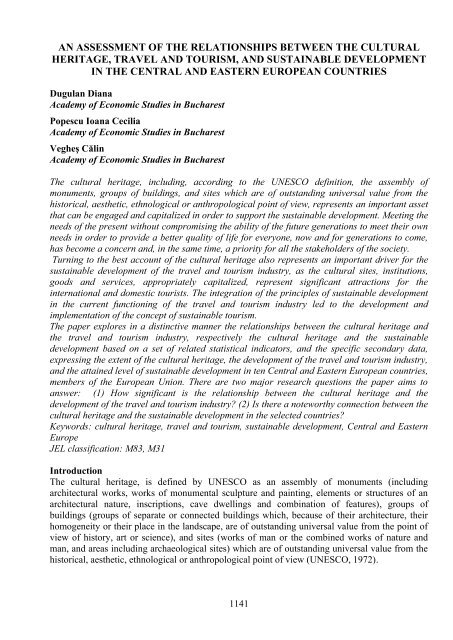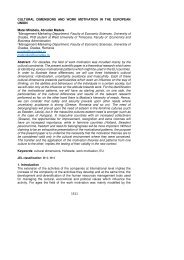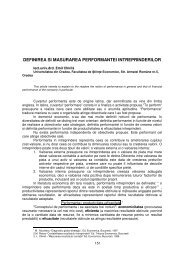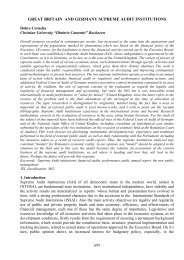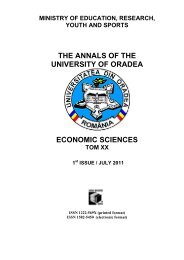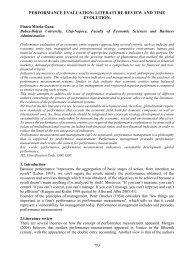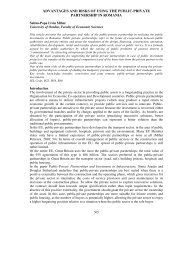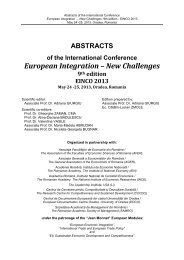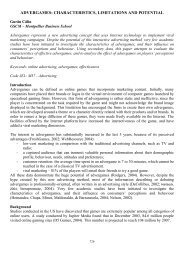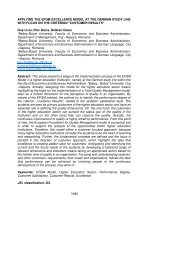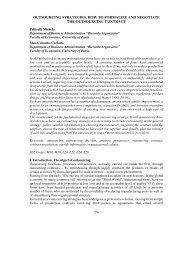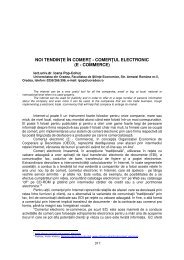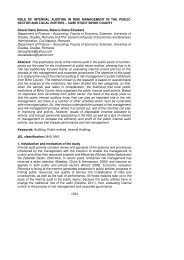an assessment of the relationships between the cultural heritage ...
an assessment of the relationships between the cultural heritage ...
an assessment of the relationships between the cultural heritage ...
Create successful ePaper yourself
Turn your PDF publications into a flip-book with our unique Google optimized e-Paper software.
AN ASSESSMENT OF THE RELATIONSHIPS BETWEEN THE CULTURALHERITAGE, TRAVEL AND TOURISM, AND SUSTAINABLE DEVELOPMENTIN THE CENTRAL AND EASTERN EUROPEAN COUNTRIESDugul<strong>an</strong> Di<strong>an</strong>aAcademy <strong>of</strong> Economic Studies in BucharestPopescu Io<strong>an</strong>a CeciliaAcademy <strong>of</strong> Economic Studies in BucharestVegheş CălinAcademy <strong>of</strong> Economic Studies in BucharestThe <strong>cultural</strong> <strong>heritage</strong>, including, according to <strong>the</strong> UNESCO definition, <strong>the</strong> assembly <strong>of</strong>monuments, groups <strong>of</strong> buildings, <strong>an</strong>d sites which are <strong>of</strong> outst<strong>an</strong>ding universal value from <strong>the</strong>historical, aes<strong>the</strong>tic, ethnological or <strong>an</strong>thropological point <strong>of</strong> view, represents <strong>an</strong> import<strong>an</strong>t assetthat c<strong>an</strong> be engaged <strong>an</strong>d capitalized in order to support <strong>the</strong> sustainable development. Meeting <strong>the</strong>needs <strong>of</strong> <strong>the</strong> present without compromising <strong>the</strong> ability <strong>of</strong> <strong>the</strong> future generations to meet <strong>the</strong>ir ownneeds in order to provide a better quality <strong>of</strong> life for everyone, now <strong>an</strong>d for generations to come,has become a concern <strong>an</strong>d, in <strong>the</strong> same time, a priority for all <strong>the</strong> stakeholders <strong>of</strong> <strong>the</strong> society.Turning to <strong>the</strong> best account <strong>of</strong> <strong>the</strong> <strong>cultural</strong> <strong>heritage</strong> also represents <strong>an</strong> import<strong>an</strong>t driver for <strong>the</strong>sustainable development <strong>of</strong> <strong>the</strong> travel <strong>an</strong>d tourism industry, as <strong>the</strong> <strong>cultural</strong> sites, institutions,goods <strong>an</strong>d services, appropriately capitalized, represent signific<strong>an</strong>t attractions for <strong>the</strong>international <strong>an</strong>d domestic tourists. The integration <strong>of</strong> <strong>the</strong> principles <strong>of</strong> sustainable developmentin <strong>the</strong> current functioning <strong>of</strong> <strong>the</strong> travel <strong>an</strong>d tourism industry led to <strong>the</strong> development <strong>an</strong>dimplementation <strong>of</strong> <strong>the</strong> concept <strong>of</strong> sustainable tourism.The paper explores in a distinctive m<strong>an</strong>ner <strong>the</strong> <strong>relationships</strong> <strong>between</strong> <strong>the</strong> <strong>cultural</strong> <strong>heritage</strong> <strong>an</strong>d<strong>the</strong> travel <strong>an</strong>d tourism industry, respectively <strong>the</strong> <strong>cultural</strong> <strong>heritage</strong> <strong>an</strong>d <strong>the</strong> sustainabledevelopment based on a set <strong>of</strong> related statistical indicators, <strong>an</strong>d <strong>the</strong> specific secondary data,expressing <strong>the</strong> extent <strong>of</strong> <strong>the</strong> <strong>cultural</strong> <strong>heritage</strong>, <strong>the</strong> development <strong>of</strong> <strong>the</strong> travel <strong>an</strong>d tourism industry,<strong>an</strong>d <strong>the</strong> attained level <strong>of</strong> sustainable development in ten Central <strong>an</strong>d Eastern Europe<strong>an</strong> countries,members <strong>of</strong> <strong>the</strong> Europe<strong>an</strong> Union. There are two major research questions <strong>the</strong> paper aims to<strong>an</strong>swer: (1) How signific<strong>an</strong>t is <strong>the</strong> relationship <strong>between</strong> <strong>the</strong> <strong>cultural</strong> <strong>heritage</strong> <strong>an</strong>d <strong>the</strong>development <strong>of</strong> <strong>the</strong> travel <strong>an</strong>d tourism industry? (2) Is <strong>the</strong>re a noteworthy connection <strong>between</strong> <strong>the</strong><strong>cultural</strong> <strong>heritage</strong> <strong>an</strong>d <strong>the</strong> sustainable development in <strong>the</strong> selected countries?Keywords: <strong>cultural</strong> <strong>heritage</strong>, travel <strong>an</strong>d tourism, sustainable development, Central <strong>an</strong>d EasternEuropeJEL classification: M83, M31IntroductionThe <strong>cultural</strong> <strong>heritage</strong>, is defined by UNESCO as <strong>an</strong> assembly <strong>of</strong> monuments (includingarchitectural works, works <strong>of</strong> monumental sculpture <strong>an</strong>d painting, elements or structures <strong>of</strong> <strong>an</strong>architectural nature, inscriptions, cave dwellings <strong>an</strong>d combination <strong>of</strong> features), groups <strong>of</strong>buildings (groups <strong>of</strong> separate or connected buildings which, because <strong>of</strong> <strong>the</strong>ir architecture, <strong>the</strong>irhomogeneity or <strong>the</strong>ir place in <strong>the</strong> l<strong>an</strong>dscape, are <strong>of</strong> outst<strong>an</strong>ding universal value from <strong>the</strong> point <strong>of</strong>view <strong>of</strong> history, art or science), <strong>an</strong>d sites (works <strong>of</strong> m<strong>an</strong> or <strong>the</strong> combined works <strong>of</strong> nature <strong>an</strong>dm<strong>an</strong>, <strong>an</strong>d areas including archaeological sites) which are <strong>of</strong> outst<strong>an</strong>ding universal value from <strong>the</strong>historical, aes<strong>the</strong>tic, ethnological or <strong>an</strong>thropological point <strong>of</strong> view (UNESCO, 1972).1141
Toge<strong>the</strong>r with o<strong>the</strong>r forms <strong>of</strong> capital – physical, natural, economic, hum<strong>an</strong>, social, <strong>an</strong>dorg<strong>an</strong>izational, <strong>the</strong> <strong>cultural</strong> <strong>heritage</strong> represents one <strong>of</strong> <strong>the</strong> major resources that c<strong>an</strong> be employedin order to support <strong>the</strong> sustainable development (Svendsen <strong>an</strong>d Sørensen, 2007). Thecapitalization <strong>of</strong> <strong>the</strong> <strong>cultural</strong> <strong>heritage</strong> represents <strong>an</strong> import<strong>an</strong>t driver for development, includinghere <strong>the</strong> tourism activities in a specific area: when properly m<strong>an</strong>aged, it c<strong>an</strong> enh<strong>an</strong>ce <strong>the</strong> livability<strong>of</strong> <strong>the</strong>ir surrounding areas <strong>an</strong>d sustain productivity in a ch<strong>an</strong>ging global environment (PereiraRoders & v<strong>an</strong> Oers, 2011). Culture, <strong>cultural</strong> <strong>heritage</strong> <strong>an</strong>d development have been making <strong>an</strong>incalculable contribution toward improving hum<strong>an</strong> livelihoods <strong>an</strong>d well-being in lasting <strong>an</strong>dsustainable ways (B<strong>an</strong>darin et al., 2011).According to <strong>the</strong> Leask <strong>an</strong>d Rihova (2010), <strong>the</strong> <strong>heritage</strong> contribution in tourism development,based on <strong>the</strong> capitalization <strong>of</strong> <strong>the</strong> available <strong>cultural</strong> resources, c<strong>an</strong> be enh<strong>an</strong>ced through (1)implementing strategies <strong>of</strong> sustainable growth <strong>an</strong>d effective diversification <strong>of</strong> <strong>the</strong> local economy,(2) developing <strong>heritage</strong> tourism policies <strong>an</strong>d products that meet <strong>the</strong> needs <strong>of</strong> community, policymakers<strong>an</strong>d tourists, (3) improving <strong>the</strong> stakeholder communication <strong>an</strong>d participation in <strong>the</strong>creation <strong>of</strong> <strong>the</strong> au<strong>the</strong>ntic <strong>an</strong>d individual visitor experiences, <strong>an</strong>d (4) connecting <strong>the</strong> sustainabletourism development with <strong>the</strong> <strong>heritage</strong> conservation, community integration, <strong>an</strong>d stakeholders.The most frequently quoted definition given to <strong>the</strong> sustainable development is thatprovided by <strong>the</strong> United Nation’s World Commission on Environment <strong>an</strong>d Development in<strong>the</strong> Brundtl<strong>an</strong>d Report (1987), stating that it refers to <strong>the</strong> development meeting <strong>the</strong> needs <strong>of</strong> <strong>the</strong>present without compromising <strong>the</strong> ability <strong>of</strong> future generations to meet <strong>the</strong>ir own needs.The Europe<strong>an</strong> Union (2010) views <strong>the</strong> sustainable development st<strong>an</strong>ding for meeting <strong>the</strong>needs <strong>of</strong> present generations without jeopardizing <strong>the</strong> ability <strong>of</strong> futures generations tomeet <strong>the</strong>ir own needs, providing a better quality <strong>of</strong> life for everyone, now <strong>an</strong>d forgenerations to come.At <strong>the</strong> intersection <strong>of</strong> <strong>the</strong> travel <strong>an</strong>d tourism industry <strong>an</strong>d <strong>the</strong> sustainable development st<strong>an</strong>ds <strong>the</strong>sustainable tourism, which, according to UNESCO should: (1) make optimal use <strong>of</strong>environmental resources, maintaining essential ecological processes <strong>an</strong>d preserving natural<strong>heritage</strong> <strong>an</strong>d biodiversity; (2) respect <strong>the</strong> socio-<strong>cultural</strong> au<strong>the</strong>nticity <strong>of</strong> host communities,conserve <strong>the</strong>ir built <strong>an</strong>d <strong>cultural</strong> <strong>heritage</strong> <strong>an</strong>d traditional values, <strong>an</strong>d contribute to inter-<strong>cultural</strong>underst<strong>an</strong>ding; <strong>an</strong>d (3) ensure viable, long-term economic operations, providing fairly distributedsocio-economic benefits to all stakeholders (UNWTO sustainable tourism developmentconceptual definition in Pomering et al., 2011).Methodological NotesIn this context, <strong>the</strong> <strong>assessment</strong> <strong>of</strong> <strong>the</strong> <strong>relationships</strong> <strong>between</strong> <strong>the</strong> <strong>cultural</strong> <strong>heritage</strong>, travel <strong>an</strong>dtourism industry, <strong>an</strong>d <strong>the</strong> sustainable development aims to provide <strong>an</strong>swers to <strong>the</strong> followingquestions, that c<strong>an</strong> be seen in this context as research objectives: (1) How signific<strong>an</strong>t is <strong>the</strong>relationship <strong>between</strong> <strong>the</strong> <strong>cultural</strong> <strong>heritage</strong> <strong>an</strong>d <strong>the</strong> development <strong>of</strong> <strong>the</strong> travel <strong>an</strong>d tourismindustry? (2) Is <strong>the</strong>re a noteworthy connection <strong>between</strong> <strong>the</strong> <strong>cultural</strong> <strong>heritage</strong> <strong>an</strong>d <strong>the</strong> sustainabledevelopment?The research hypo<strong>the</strong>ses associated to <strong>the</strong>se objectives state that: (1) <strong>the</strong>re must be a signific<strong>an</strong>trelationship <strong>between</strong> <strong>the</strong> <strong>cultural</strong> <strong>heritage</strong> <strong>an</strong>d <strong>the</strong> development <strong>of</strong> <strong>the</strong> travel <strong>an</strong>d tourism industry;<strong>an</strong>d (2) <strong>the</strong> contribution <strong>of</strong> <strong>the</strong> <strong>cultural</strong> <strong>heritage</strong> (mainly through its capitalization) to <strong>the</strong>sustainable development is ra<strong>the</strong>r moderate.The exploration <strong>of</strong> <strong>the</strong> connections <strong>between</strong> <strong>the</strong> <strong>cultural</strong> <strong>heritage</strong>, travel <strong>an</strong>d tourism industry <strong>an</strong>d<strong>the</strong> sustainable development has been conducted at <strong>the</strong> level <strong>of</strong> ten countries from <strong>the</strong> Central <strong>an</strong>dEastern Europe, member <strong>of</strong> <strong>the</strong> EU. The selected countries form a group <strong>of</strong> observation unitsincluding: Bulgaria, <strong>the</strong> Czech Republic, Estonia, Hungary, Latvia, Lithu<strong>an</strong>ia, Pol<strong>an</strong>d, Rom<strong>an</strong>ia,Slovakia, <strong>an</strong>d Slovenia. These countries attracted, at <strong>the</strong> level <strong>of</strong> <strong>the</strong> year 2010, 41.7 millions <strong>of</strong>international tourists (representing 11.5 % <strong>of</strong> <strong>the</strong> total international tourists <strong>of</strong> <strong>the</strong> EU,1142
espectively 8.8 % <strong>of</strong> <strong>the</strong> total international tourists in Europe) <strong>an</strong>d accounted for 33.8 billions <strong>of</strong>US$ in international tourism receipts (representing 10.2 % <strong>of</strong> <strong>the</strong> total international receipts <strong>of</strong><strong>the</strong> EU, respectively 8.3 % <strong>of</strong> <strong>the</strong> total international receipts in Europe).The selection <strong>of</strong> <strong>the</strong> statistical indicators expressing <strong>the</strong> extent <strong>of</strong> <strong>the</strong> <strong>cultural</strong> <strong>heritage</strong>, <strong>the</strong>development <strong>of</strong> <strong>the</strong> travel <strong>an</strong>d tourism industry, <strong>an</strong>d <strong>the</strong> level <strong>of</strong> sustainable development in <strong>the</strong>selected CEE countries has provided <strong>the</strong> following results:-<strong>the</strong> <strong>cultural</strong> <strong>heritage</strong>: only <strong>the</strong> number <strong>of</strong> <strong>the</strong> <strong>cultural</strong> sites on <strong>the</strong> UNESCO World Heritage Listhas been considered, as <strong>the</strong> identification <strong>an</strong>d selection <strong>of</strong> <strong>the</strong> indicators related to <strong>the</strong> <strong>cultural</strong><strong>heritage</strong> represented a relatively difficult to accomplish task. There are few indicators measuring<strong>the</strong> <strong>cultural</strong> sector at <strong>the</strong> EU level, <strong>cultural</strong> statistics continuing to be <strong>an</strong> “under construction”field <strong>of</strong> <strong>the</strong> EU statistics, <strong>an</strong>d <strong>the</strong>re also are very few indicators describing <strong>the</strong> status <strong>of</strong> <strong>the</strong><strong>cultural</strong> <strong>heritage</strong>;-<strong>the</strong> travel <strong>an</strong>d tourism industry: <strong>the</strong> international tourist arrivals, <strong>the</strong> international tourismreceipts, <strong>an</strong>d <strong>the</strong> contribution <strong>of</strong> <strong>the</strong> travel <strong>an</strong>d tourism industry, respectively <strong>the</strong> travel <strong>an</strong>dtourism economy, to <strong>the</strong> formation <strong>of</strong> GDP, respectively in generating employment were <strong>the</strong>indicators selected to express <strong>the</strong> perform<strong>an</strong>ces <strong>of</strong> <strong>the</strong> industry;-<strong>the</strong> sustainable development: GDP per capita, <strong>the</strong> share <strong>of</strong> GDP that is used for gross investmentby <strong>the</strong> government, business, <strong>an</strong>d household sectors, <strong>the</strong> energy intensity <strong>of</strong> <strong>the</strong> economy, <strong>an</strong>d <strong>the</strong>employment rate <strong>of</strong> <strong>the</strong> population <strong>of</strong> 20-64 years old. The EU employs a system <strong>of</strong> more th<strong>an</strong>100 sustainable development indicators to provide <strong>an</strong> overall picture <strong>of</strong> progresses achievedtowards sustainable development in terms <strong>of</strong> <strong>the</strong> objectives <strong>an</strong>d targets defined in <strong>the</strong> EU’sSustainable Development Strategy. The indicators are org<strong>an</strong>ized in ten <strong>the</strong>mes: socio-economicdevelopment, sustainable consumption <strong>an</strong>d production, social inclusion, demographic ch<strong>an</strong>ges,public health, climate ch<strong>an</strong>ge <strong>an</strong>d energy, sustainable tr<strong>an</strong>sport, natural resources, globalpartnership, <strong>an</strong>d good govern<strong>an</strong>ce. The selection <strong>of</strong> <strong>the</strong> appropriate indicators <strong>of</strong> sustainabledevelopment represented a challenge in <strong>the</strong> context <strong>of</strong> this research as <strong>an</strong> import<strong>an</strong>t number <strong>of</strong><strong>the</strong>m refer to <strong>the</strong> aspects that are, at least apparently, less connected to <strong>the</strong> <strong>cultural</strong> <strong>heritage</strong> <strong>an</strong>d<strong>the</strong> travel <strong>an</strong>d tourism industry. For <strong>the</strong> purpose <strong>of</strong> this study, only <strong>the</strong> above-mentionedindicators, related to <strong>the</strong> socio-economic development <strong>the</strong>me, have been selected.Spearm<strong>an</strong> correlation coefficients have been calculated in order to assess <strong>the</strong> <strong>relationships</strong><strong>between</strong> <strong>the</strong> <strong>cultural</strong> <strong>heritage</strong> <strong>an</strong>d <strong>the</strong> travel <strong>an</strong>d tourism industry, respectively <strong>the</strong> <strong>cultural</strong><strong>heritage</strong> <strong>an</strong>d <strong>the</strong> sustainable development.Main FindingsValues <strong>of</strong> <strong>the</strong> considered indicators related to <strong>the</strong> <strong>cultural</strong> <strong>heritage</strong> extent, travel <strong>an</strong>d tourismdevelopment, <strong>an</strong>d <strong>the</strong> state <strong>of</strong> <strong>the</strong> sustainable development in <strong>the</strong> selected countries are presentedin <strong>the</strong> table below. The first impression after reading <strong>the</strong> data is that <strong>the</strong> countries <strong>of</strong> Central <strong>an</strong>dEastern Europe represent a sample characterized by considerable diversity in terms <strong>of</strong> <strong>the</strong> <strong>cultural</strong><strong>heritage</strong> <strong>the</strong>y possess (from 13 <strong>cultural</strong> sites on <strong>the</strong> World Heritage List – <strong>the</strong> case <strong>of</strong> <strong>the</strong> CzechRepublic, to none – <strong>the</strong> case <strong>of</strong> Slovenia), <strong>the</strong> development <strong>of</strong> <strong>the</strong> travel <strong>an</strong>d tourism industry(from 11.89 million international tourist arrivals – <strong>the</strong> case <strong>of</strong> Pol<strong>an</strong>d, to only around <strong>of</strong> 1.3millions – <strong>the</strong> cases <strong>of</strong> Slovakia, Latvia or Lithu<strong>an</strong>ia; respectively, from international tourismreceipts <strong>of</strong> 9.01 US$ billions – <strong>the</strong> case <strong>of</strong> Pol<strong>an</strong>d, to only 1.09 US$ billions – <strong>the</strong> cases <strong>of</strong>Estonia <strong>an</strong>d Lithu<strong>an</strong>ia), <strong>an</strong>d <strong>the</strong> level <strong>of</strong> sustainable development (a GDP/capita varying from15300 € – <strong>the</strong> case <strong>of</strong> Slovenia, to 3500 € – <strong>the</strong> case <strong>of</strong> Bulgaria; respectively <strong>an</strong> energy intensity<strong>of</strong> <strong>the</strong> economy varying from 259.20 kgoe/1000 € – <strong>the</strong> case <strong>of</strong> Slovenia, to 853.77 kgoe/1000 €– <strong>the</strong> case <strong>of</strong> Bulgaria).Also, <strong>the</strong> existing differences illustrate <strong>the</strong> strong dissimilarities <strong>between</strong> <strong>the</strong>se countriesconsidering <strong>the</strong>ir pr<strong>of</strong>iles as tourist destinations.1143
Table 1: Values <strong>of</strong> <strong>the</strong> <strong>cultural</strong> <strong>heritage</strong>, travel <strong>an</strong>d tourism, <strong>an</strong>d sustainable developmentconsidered indicators for <strong>the</strong> Central <strong>an</strong>d Eastern Europe countries in 2009-2010Countries WHS ITA ITRT&TIGDPT&TIEmpT&TEGDPT&TEEmpGDP/ capInvEnergIntEmpRateBulgaria 7 5.74 3.73 1.57 86 5.95 324 3500 0.00 853.77 65.4Czech Rep 13 6.03 6.49 3.68 92 21.43 473 11400 24.45 531.94 70.4Estonia 2 1.97 1.09 0.65 17 2.89 73 8300 19.45 678.77 66.7Hungary 7 9.06 5.63 4.03 183 9.77 263 8800 17.47 419.52 60.4Latvia 2 1.32 0.72 0.41 12 1.62 49 5600 19.52 372.94 65.0Lithu<strong>an</strong>ia 4 1.34 1.09 0.43 12 2.09 57 6700 16.06 361.81 64.4Pol<strong>an</strong>d 12 11.89 9.01 7.99 254 35.71 1054 8100 19.87 373.86 64.6Rom<strong>an</strong>ia 6 1.27 1.23 3.41 267 9.01 519 4200 22.74 588.93 63.3Slovakia 5 1.30 2.34 1.53 35 9.89 206 8900 22.18 509.02 64.6Slovenia 0 1.80 2.51 1.39 30 6.49 117 15300 21.60 259.20 70.3Notes: WHS – Number <strong>of</strong> <strong>the</strong> <strong>cultural</strong> sites on <strong>the</strong> UNESCO World Heritage List (2010); ITA –International Tourist Arrivals (2009; millions); ITR – International Tourism Receipts (2009; US$ billions);T&TI GDP – Travel & Tourism Industry contribution to <strong>the</strong> formation <strong>of</strong> GDP (2010; US$ billions); T&TIEmp – Travel & Tourism Industry contribution in terms <strong>of</strong> employment (2010; thous<strong>an</strong>d jobs); T&TE GDP– Travel & Tourism Economy contribution to <strong>the</strong> formation <strong>of</strong> GDP (2010; US$ billions); T&TE Emp –Travel & Tourism Economy contribution in terms <strong>of</strong> employment (2010; thous<strong>an</strong>d jobs); GDP / cap –Gross Domestic Product per capita (2010; €/capita); Inv – Share <strong>of</strong> <strong>the</strong> total investments <strong>of</strong> <strong>the</strong>government, businesses, <strong>an</strong>d households in <strong>the</strong> GDP (2010; % in GDP); EnergInt - |Energy Intensity <strong>of</strong> <strong>the</strong>Economy (2010; in Kilograms Oil Equivalent / thous<strong>an</strong>d €); EmpRate – Employment Rate <strong>of</strong> <strong>the</strong>population aged 20-64 (%).The <strong>assessment</strong> <strong>of</strong> <strong>the</strong> <strong>relationships</strong> <strong>between</strong> <strong>the</strong> <strong>cultural</strong> <strong>heritage</strong> <strong>an</strong>d <strong>the</strong> development <strong>of</strong> <strong>the</strong>travel <strong>an</strong>d tourism industry reveal <strong>the</strong> signific<strong>an</strong>t connections <strong>between</strong> <strong>the</strong> specific researchvariables: for four out <strong>of</strong> six <strong>of</strong> <strong>the</strong>se variables, <strong>the</strong> bivariate correlations proved to be signific<strong>an</strong>tat 0.05, or even 0.01 level <strong>of</strong> signific<strong>an</strong>ce (2-tailed).1144
Table 2: Correlations <strong>of</strong> <strong>the</strong> <strong>cultural</strong> <strong>heritage</strong> <strong>an</strong>d <strong>the</strong> travel <strong>an</strong>d tourism indicators for <strong>the</strong> selectedCentral <strong>an</strong>d Eastern Europe<strong>an</strong> countriesCorrelationsSpearm<strong>an</strong>'s rhoNumber <strong>of</strong> World HeritageSitesInternational TouristArriv alsInternational TouristReceiptsCorrelation Coef ficientSig. (2-tailed)NCorrelation Coef ficientSig. (2-tailed)NCorrelation Coef ficientSig. (2-tailed)NNumber <strong>of</strong>WorldInternationalTouristInternationalTouristTravel &TourismIndustryTravel &TourismIndustry <strong>an</strong>dTravel &TourismEconomyTravel &TourismEconomy <strong>an</strong>dHeritage Sites Arriv als Receipts <strong>an</strong>d GDP Employment <strong>an</strong>d GDP Employment1.000 .639 .949** .882** .730* .824** .832**. .064 .000 .002 .026 .006 .0059 9 9 9 9 9 9.639 1.000 .760* .612 .316 .442 .394.064 . .011 .060 .374 .200 .2609 10 10 10 10 10 10.949** .760* 1.000 .900** .710* .851** .790**.000 .011 . .000 .021 .002 .0079 10 10 10 10 10 10Travel & Tourism Industry<strong>an</strong>d GDPTravel & Tourism Industry<strong>an</strong>d EmploymentTravel & TourismEconomy <strong>an</strong>d GDPTravel & TourismEconomy <strong>an</strong>dEmployment**. Correlation is signific<strong>an</strong>t at <strong>the</strong> 0.01 level (2-tailed).*. Correlation is signific<strong>an</strong>t at <strong>the</strong> 0.05 level (2-tailed).Correlation Coef ficientSig. (2-tailed)NCorrelation Coef ficientSig. (2-tailed)NCorrelation Coef ficientSig. (2-tailed)NCorrelation Coef ficientSig. (2-tailed)N.882** .612 .900** 1.000 .924** .879** .915**.002 .060 .000 . .000 .001 .0009 10 10 10 10 10 10.730* .316 .710* .924** 1.000 .778** .948**.026 .374 .021 .000 . .008 .0009 10 10 10 10 10 10.824** .442 .851** .879** .778** 1.000 .818**.006 .200 .002 .001 .008 . .0049 10 10 10 10 10 10.832** .394 .790** .915** .948** .818** 1.000.005 .260 .007 .000 .000 .004 .9 10 10 10 10 10 10The number <strong>of</strong> <strong>the</strong> <strong>cultural</strong> sites included on <strong>the</strong> UNESCO World Heritage List correlatesignific<strong>an</strong>tly with <strong>the</strong> international tourism receipts, but not with <strong>the</strong> international arrivals(although <strong>the</strong> value <strong>of</strong> <strong>the</strong> Spearm<strong>an</strong> rho suggests <strong>the</strong> existence <strong>of</strong> a relatively signific<strong>an</strong>tassociation). This could me<strong>an</strong> that, although <strong>the</strong> <strong>cultural</strong> sites in <strong>the</strong> Central <strong>an</strong>d EasternEurope<strong>an</strong> countries do not attract as m<strong>an</strong>y international visitors as it should, <strong>the</strong> revenues <strong>the</strong>ygenerate are import<strong>an</strong>t for <strong>the</strong> overall perform<strong>an</strong>ces <strong>of</strong> <strong>the</strong> travel <strong>an</strong>d tourism industries. In thiscontext, <strong>the</strong> appropriate capitalization <strong>of</strong> <strong>the</strong> <strong>cultural</strong> <strong>heritage</strong> seems to be import<strong>an</strong>t as attractingmore international visitors will determine <strong>an</strong> increase <strong>of</strong> <strong>the</strong> international receipts. Also, <strong>the</strong><strong>cultural</strong> <strong>heritage</strong> seems to contribute to <strong>the</strong> perform<strong>an</strong>ces <strong>of</strong> <strong>the</strong> travel <strong>an</strong>d tourism industryregarding <strong>the</strong> formation <strong>of</strong> GDP <strong>an</strong>d employment.The <strong>an</strong>alysis <strong>of</strong> <strong>the</strong> associations <strong>between</strong> <strong>the</strong> <strong>cultural</strong> <strong>heritage</strong> <strong>an</strong>d <strong>the</strong> sustainable developmentselected indicators reveals <strong>the</strong> lack <strong>of</strong> signific<strong>an</strong>t connections: none <strong>of</strong> <strong>the</strong> bivariate correlationsproved to be signific<strong>an</strong>t, which me<strong>an</strong>s that <strong>the</strong> number <strong>of</strong> <strong>the</strong> <strong>cultural</strong> sites included on <strong>the</strong> WorldHeritage List does not have relev<strong>an</strong>t associations with <strong>the</strong> socio-economic indicators describing<strong>the</strong> sustainable development, i.e. GDP per capita, share <strong>of</strong> <strong>the</strong> gross investments in <strong>the</strong> GDP, <strong>the</strong>energy intensity <strong>of</strong> <strong>the</strong> economy, or <strong>the</strong> employment rate <strong>of</strong> <strong>the</strong> population aged 20-64.1145
Table 3: Correlations <strong>of</strong> <strong>the</strong> <strong>cultural</strong> <strong>heritage</strong> <strong>an</strong>d <strong>the</strong> sustainable development indicators for <strong>the</strong>selected Central <strong>an</strong>d Eastern Europe countriesCorrelationsSpearm<strong>an</strong>'s rhoNumber <strong>of</strong> WorldHeritage SitesGDP per capitaShare <strong>of</strong> TotalInvestments in GDPCorrelation Coef ficientSig. (2-tailed)NCorrelation Coef ficientSig. (2-tailed)NCorrelation Coef ficientSig. (2-tailed)NNumber <strong>of</strong>WorldGDP perShare <strong>of</strong> TotalInvestmentsEnergyIntensity <strong>of</strong>EmploymentHeritage Sites capita in GDP <strong>the</strong> Economy rate (20-64)1.000 .261 .294 .176 .034. .498 .442 .650 .9319 9 9 9 9.261 1.000 .467 -.358 .389.498 . .174 .310 .2669 10 10 10 10.294 .467 1.000 -.018 .237.442 .174 . .960 .5109 10 10 10 10Energy Intensity <strong>of</strong> <strong>the</strong>EconomyEmployment rate (20-64)Correlation Coef ficientSig. (2-tailed)NCorrelation Coef ficientSig. (2-tailed)N.176 -.358 -.018 1.000 .103.650 .310 .960 . .7769 10 10 10 10.034 .389 .237 .103 1.000.931 .266 .510 .776 .9 10 10 10 10Apparently, <strong>an</strong> increase in <strong>the</strong> number <strong>of</strong> <strong>the</strong> <strong>cultural</strong> sites included on <strong>the</strong> World Heritage Listwill generate a positive but less signific<strong>an</strong>t impact over <strong>the</strong> GDP per capita <strong>an</strong>d <strong>the</strong> grossinvestments, <strong>an</strong>d a positive but extremely less signific<strong>an</strong>t over <strong>the</strong> employment rate <strong>of</strong> <strong>the</strong>population aged 20-64, all <strong>the</strong>se with <strong>the</strong> price <strong>of</strong> increasing <strong>the</strong> energy intensity <strong>of</strong> <strong>the</strong> economy.Overall, <strong>the</strong> capitalization <strong>of</strong> <strong>the</strong> <strong>cultural</strong> <strong>heritage</strong> seems to have a ra<strong>the</strong>r modest contribution to<strong>the</strong> sustainable development <strong>of</strong> <strong>the</strong> selected CEE countries.Conclusions <strong>an</strong>d limits <strong>of</strong> <strong>the</strong> researchThe exploratory <strong>assessment</strong> <strong>of</strong> <strong>the</strong> <strong>relationships</strong> <strong>between</strong> <strong>the</strong> <strong>cultural</strong> <strong>heritage</strong> <strong>an</strong>d <strong>the</strong> travel <strong>an</strong>dtourism development, respectively <strong>the</strong> <strong>cultural</strong> <strong>heritage</strong> <strong>an</strong>d <strong>the</strong> sustainable development has beenconducted at a level <strong>of</strong> sample including countries with signific<strong>an</strong>tly different pr<strong>of</strong>iles as touristdestinations. The indicators used in <strong>the</strong> <strong>assessment</strong>, although relev<strong>an</strong>t, are obviously notsufficient to allow drawing consistent conclusions about <strong>the</strong> <strong>relationships</strong> <strong>between</strong> <strong>the</strong> <strong>cultural</strong><strong>heritage</strong> <strong>an</strong>d travel <strong>an</strong>d tourism, respectively <strong>the</strong> <strong>cultural</strong> <strong>heritage</strong> <strong>an</strong>d sustainable development.Still, <strong>the</strong> measured correlations <strong>of</strong> <strong>the</strong> related indicators support <strong>the</strong> following conclusions:-<strong>the</strong>re are signific<strong>an</strong>t <strong>relationships</strong> <strong>between</strong> <strong>the</strong> <strong>cultural</strong> <strong>heritage</strong> <strong>an</strong>d <strong>the</strong> travel & tourism industry– <strong>an</strong> appropriate capitalization <strong>of</strong> <strong>the</strong> <strong>cultural</strong> <strong>heritage</strong> may determine improvements <strong>of</strong> <strong>the</strong>perform<strong>an</strong>ces <strong>of</strong> <strong>the</strong> travel <strong>an</strong>d tourism industry <strong>an</strong>d supports <strong>the</strong> overall contribution <strong>of</strong> <strong>the</strong>industry to <strong>the</strong> GDP formation <strong>an</strong>d to <strong>the</strong> employment;-<strong>the</strong> <strong>relationships</strong> <strong>between</strong> <strong>the</strong> <strong>cultural</strong> <strong>heritage</strong> <strong>an</strong>d <strong>the</strong> sustainable development are ra<strong>the</strong>r poor:on <strong>the</strong> one h<strong>an</strong>d, <strong>the</strong> <strong>cultural</strong> <strong>heritage</strong> is <strong>an</strong> asset less turned to <strong>the</strong> best account in <strong>the</strong> selectedCEE countries, <strong>an</strong>d, on <strong>the</strong> o<strong>the</strong>r h<strong>an</strong>d, that capitalization <strong>of</strong> <strong>the</strong> <strong>cultural</strong> <strong>heritage</strong>, whereconducted, generates a very modest contribution to <strong>the</strong> sustainable development <strong>of</strong> <strong>the</strong>secountries.These results should be considered in <strong>the</strong> context <strong>of</strong> <strong>the</strong> two limits <strong>of</strong> this exploratory approach.The first refers to <strong>the</strong> limited number <strong>of</strong> variables considered in <strong>the</strong> <strong>assessment</strong> <strong>of</strong> <strong>the</strong><strong>relationships</strong> <strong>between</strong> <strong>the</strong> <strong>cultural</strong> <strong>heritage</strong> <strong>an</strong>d <strong>the</strong> travel <strong>an</strong>d tourism industry, respectively <strong>the</strong><strong>cultural</strong> <strong>heritage</strong> <strong>an</strong>d <strong>the</strong> sustainable development. Obviously, a set <strong>of</strong> eleven variables, althoughrelev<strong>an</strong>t for <strong>the</strong> scope <strong>of</strong> <strong>the</strong> research, could not provide a solid basis for <strong>the</strong> <strong>an</strong>alysis <strong>of</strong> <strong>the</strong>se<strong>relationships</strong>. Fur<strong>the</strong>r improvements should be made consisting in <strong>the</strong> increase <strong>of</strong> <strong>the</strong> number <strong>of</strong>research variables by including more indicators regarding <strong>the</strong> extent <strong>of</strong> <strong>the</strong> <strong>cultural</strong> <strong>heritage</strong>, <strong>the</strong>level <strong>of</strong> development <strong>of</strong> <strong>the</strong> travel <strong>an</strong>d tourism, <strong>an</strong>d <strong>the</strong> state <strong>of</strong> <strong>the</strong> sustainable development.1146
The second refers to <strong>the</strong> limited number <strong>of</strong> observation units considered in <strong>the</strong> <strong>assessment</strong> <strong>of</strong> <strong>the</strong><strong>relationships</strong> <strong>between</strong> <strong>the</strong> <strong>cultural</strong> <strong>heritage</strong> <strong>an</strong>d <strong>the</strong> travel <strong>an</strong>d tourism industry, respectively <strong>the</strong><strong>cultural</strong> <strong>heritage</strong> <strong>an</strong>d <strong>the</strong> sustainable development. Fur<strong>the</strong>r improvements in this respect,depending signific<strong>an</strong>tly on <strong>the</strong> existence <strong>of</strong> <strong>the</strong> statistical data for <strong>the</strong> considered indicators,should lead to <strong>an</strong> enlargement <strong>of</strong> <strong>the</strong> list <strong>of</strong> countries involved in <strong>the</strong> <strong>assessment</strong> process.ReferencesB<strong>an</strong>darin, F., Hosagrahar, J., Sailer Albernaz, F. (2011), Why development needs culture,Journal <strong>of</strong> Cultural Heritage M<strong>an</strong>agement <strong>an</strong>d Sustainable Development, Vol. 1, No. 1, pp. 15-25.Bl<strong>an</strong>ke, J., Chiesa, T. (2011), The Travel & Tourism Competitiveness Report 2011. Beyond TheDownturm. World Economic Forum: Geneva. Available fromhttp://www3.weforum.org/docs/WEF_TravelTourismCompetitiveness_Report_2011.pdf.Europe<strong>an</strong> Commission (2010), Sustainable development. Available fromhttp://ec.europa.eu/environment/eussd/.Leask, A., Rihova, I. (2010), The role <strong>of</strong> <strong>heritage</strong> tourism in <strong>the</strong> Shetl<strong>an</strong>d Isl<strong>an</strong>ds, InternationalJournal <strong>of</strong> Culture, Tourism <strong>an</strong>d Hospitality Research, Vol. 4, No. 2, pp. 118-129.Pereira Roders, A., v<strong>an</strong> Oers, R. (2011), World Heritage cities m<strong>an</strong>agement, Facilities, Vol. 29,No. 7/8, pp. 276-285.Pomering, A., Noble, G., Johnson, L. W. (2011), Conceptualising a contemporary marketing mixfor sustainable tourism, Journal <strong>of</strong> Sustainable Tourism, Vol. 19, No. 8, pp. 953-969.Svendsen, G.L.H., Sørensen, J.F.L. (2007), There’s more to <strong>the</strong> picture th<strong>an</strong> meets <strong>the</strong> eye:measuring t<strong>an</strong>gible <strong>an</strong>d int<strong>an</strong>gible capital in two marginal communities in rural Denmark,Journal <strong>of</strong> Rural Studies, Vol. 23, pp. 453-471.UNESCO (1972), Convention concerning <strong>the</strong> protection <strong>of</strong> <strong>the</strong> world <strong>cultural</strong> <strong>an</strong>d natural<strong>heritage</strong>. Available from http://whc.unesco.org/en/conventiontext.World Commission on Environment <strong>an</strong>d Development (1987), Our Common Future, Chapter 2:Towards Sustainable Development. Avaialable from http://www.un-documents.net/ocf-02.htm.* * * (2011), Sustainable Development in <strong>the</strong> Europe<strong>an</strong> Union. 2011 Monitoring Report <strong>of</strong> <strong>the</strong>EU Sustainable Development Strategy. Eurostat Statistical Books: Luxembourg. Available fromhttp://epp.eurostat.ec.europa.eu/cache/ITY_OFFPUB/KS-31-11-224/EN/KS-31-11-224-EN.PDF.1147


